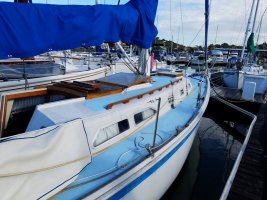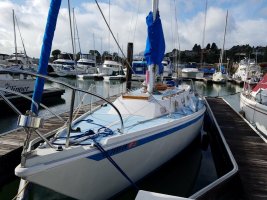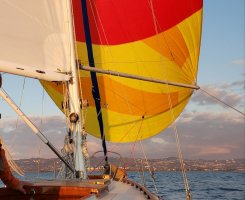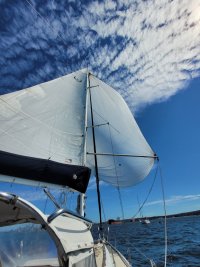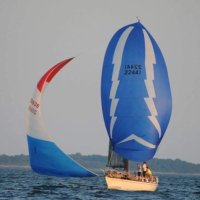Farlander
Member II
Maybe the wrong category but I'm looking for instant gratification!
I have just come into possession (for free) of a used spinnaker and pole (they both came from two different boats). The pole is about 15' long and the symmetrical spinnaker is 50' luff by 34' foot. I have a 1 1/4" track on front of the mast, and plan to install a sliding car with a pole ring (with a locking pin AND bails to rig for hoisting).
I plan to use the nose down method of gybing the pole since one of the release cable is almost full length on one end, but only about a foot long on the mast end.
There is no bridle (yet).
I have a mast head halyard for the spinnaker, and a mid-mast sheave for the topping lift. For now, I plan to run the topping lift to the pole end.
I plan to run 2 sheets (sheet + guy) to some stern blocks and turn them to the secondary or primary winches.
Big question is what are people doing for down haul on these boats? Tweakers and no down haul? Foreguy attached to block in center of foredeck? I was considering stanchion mounted blocks, and one continuous loop of line that would run through the pole end and back to cam cleats already mounted on the side of the cabin top.
Thanks in advance!
I have just come into possession (for free) of a used spinnaker and pole (they both came from two different boats). The pole is about 15' long and the symmetrical spinnaker is 50' luff by 34' foot. I have a 1 1/4" track on front of the mast, and plan to install a sliding car with a pole ring (with a locking pin AND bails to rig for hoisting).
I plan to use the nose down method of gybing the pole since one of the release cable is almost full length on one end, but only about a foot long on the mast end.
There is no bridle (yet).
I have a mast head halyard for the spinnaker, and a mid-mast sheave for the topping lift. For now, I plan to run the topping lift to the pole end.
I plan to run 2 sheets (sheet + guy) to some stern blocks and turn them to the secondary or primary winches.
Big question is what are people doing for down haul on these boats? Tweakers and no down haul? Foreguy attached to block in center of foredeck? I was considering stanchion mounted blocks, and one continuous loop of line that would run through the pole end and back to cam cleats already mounted on the side of the cabin top.
Thanks in advance!
Last edited:


